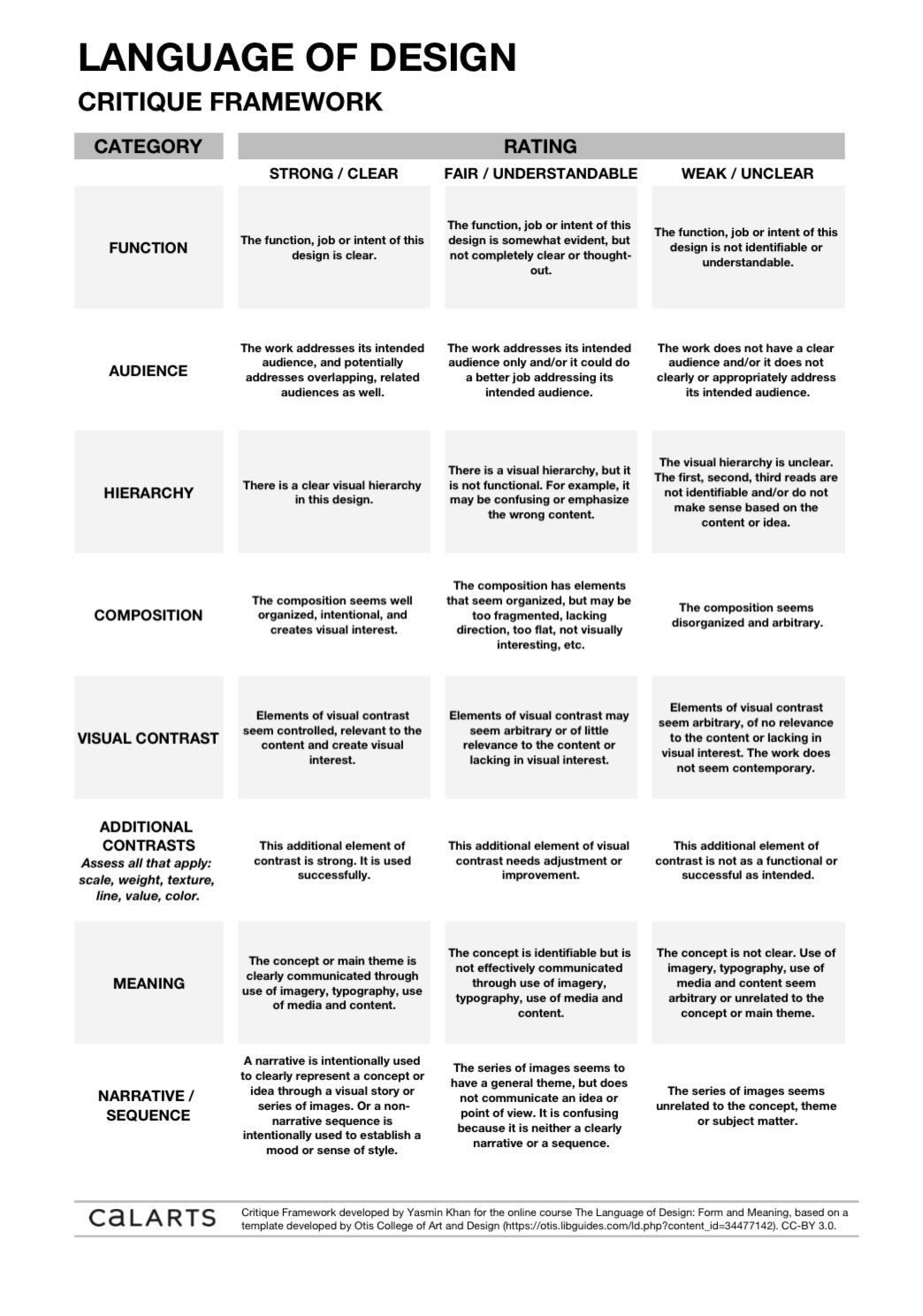In June 2023, I started the COURSERA workshop offered by caLARTS called THE LANGUAGE OF DESIGN: FORM & MEANING. The course is described as:
“In this course, critique is defined as a detailed, objective analysis of a work of graphic design and its effectiveness. Critique is an integral part of the making process for designers: it’s not just how we determine if a work of design is or is not successful, it’s how we move our work forward. Critique is also where other voices and opinions can be brought into the design process.
This course will introduce a lexicon (or vocabulary) in order for you to demonstrate clearer and more considered ways of talking about graphic design in the context of critique. Through this lexicon and a provided Critique Framework, we will model and then practice objectively describing how well a work of design functions based on specific, clearly articulated criteria. By refining this skill, you will enhance your ability to communicate about design with peers, colleagues, and clients.”
This blog will serve as a repository of my notes and written reflections. As I’m studying to be an artist, I’ll also examine and link to sources that discuss critique forms fine arts context.
Week 1 - Course Orientation & Overview
In this module we'll explain what this course is about and share guidelines surrounding our expectations for course communication and assignment submissions.
Section 1: Course Overview
1.2. Defining Critique
Specifically, the course argues that a critique functions as:
The following is a screenshot that gives an overview of how critique can best function for not only designers, but for artists as well:
Finally, the course also describes how a critique works best when it is…
The course is centred on design, but in terms of a fine art context, I believe a critique between artists discussing a work in progress can venture into the subjective, especially if the work is trying to convey a story and if any of the artists have experienced similar experiences or dealt with similar themes and ideas. I find this kind of critique comes more easily in 3rd and 4th year courses, where the work becomes more personalized and complex than work of the first two years when emerging artists are concentrating more on formal techniques, and less on the ideas that an artwork might explore.
Review…
The following statements are considered ineffective in a critique:
“I don’t like it.”
“The image reminds me of a painting my grandmother had hanging over her sofa in her living room.”
“This work is bland and boring.”
The following statement would be effective in a critique:
“This poster has a strong visual hierarchy that is clearly articulated in the design. The visual emphasis on the title - “There is no Planet B” - clearly communicates its primary message: climate change awareness.”
The last statement is considered to be effective because:
It includes a quantitative rating (“strong”) for a specific criteria (“visual hierarchy”). The statement identifies a specific criteria (“visual hierarchy”) and assigns a value (“strong”) to that criteria- namely, how well the designer has realized that component of the design. The Critique Framework, was designed to help specifically with that rating.
It points to specific evidence in the design that supports the rating. It’s not enough to just say the visual hierarchy is strong. To help a designer move a work forward, you need to articulate what elements of the work are contributing to that rating or assessment.
1.3. Using the Lexicon and the Critique Frame
1.4. About the Critique Framework
The Critique Framework is designed to help you assign a quantitative value, from strong to fair to weak, within one of a set of categories, and then rationalize your rating based on evidence within the work itself.
Additional Resources…
The following resources look at critique and the elements of fine art from a fine art perspective…
Barenscott, Dorothy. “Elements of Art: FORM, CONTENT, CONTEXT.” Avant-Guardian Mussings, 13 Oct 2010.
Barenscott, Dorothy. “Focus on Fundamentals of Visual Art & Culture: FORM.” Avant-Guardian Mussings, 14 Jan 2016.
Barenscott, Dorothy. “Focus on Fundamentals of Visual Art & Culture: CONTENT.” Avant-Guardian Mussings, 19 Jan 2016.
Barenscott, Dorothy. “Focus on Fundamentals of Visual Art & Culture: CONTEXT.” Avant-Guardian Mussings, 23 Jan 2016.
Barenscott, Dorothy. “Focus on Fundamentals: What is Analysis? FIVE STEPS TO EFFECTIVELY ADDRESS THE “HOW” OR “WHY” OF IDEAS/IMAGES/OBJECTS.” Avant-Guardian Mussings, 25 Oct 2019.
Barenscott, Dorothy. “Focus on Fundamentals: What is Synthesis?” Avant-Guardian Mussings, 12 Jan 2020.
Barenscott, Dorothy. “Focus on Fundamentals: How to Visit An Art Gallery.” Avant-Guardian Mussings, 7 Feb 2018.
Fussell, Matt. “The Importance of Critique in Art.” The Virtual Instructor.
Fussell, Matt. “The Steps to Art Criticism.” The Virtual Instructor.
Oh, Yoojin. “A BEGINNER'S GUIDE TO CONSTRUCTIVE ART CRITIQUES.” Kadenze Blog, 21 Sep 2018.
Saylor Academy. “Module 3: Visual Language: The Elements of Art.”
Saylor Academy. “Unit 4: How Art Works – The Principles of Visual Language.”
Sotto, Theresa. “Art Critiques Made Easy: 7 tips for leading classroom discussions about works of art.” The Kennedy Centre, 13 Dec 2019.
Tate. “Featured Art Terms.” The Tate Modern.
VIDEO > ArtProf: Create & Critique. “How to Critique Art: Art School Classroom Critique with RISD Art Professor.” YouTube, 28 May 2020.
Video > Art Prof: Create & Critique. “How to Critique Art for Beginners: RISD Art Professor & Art Students Explain.” YouTube, 5 Mar 2020.
VIDEO > TED-Ed. “How Art Can Help You Analyze - Amy E Herman.” YouTube, 4 Oct 2013.



